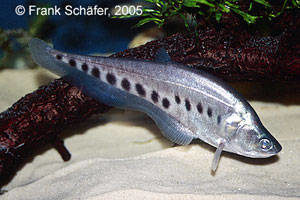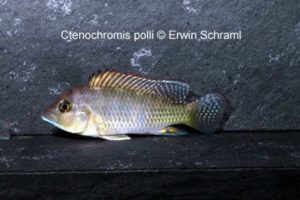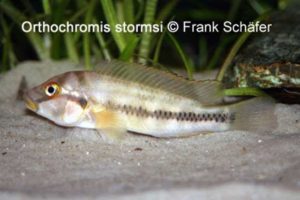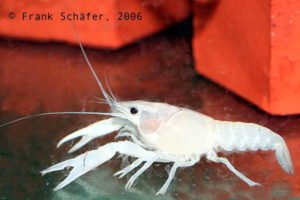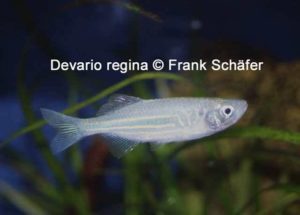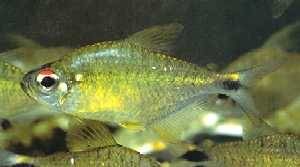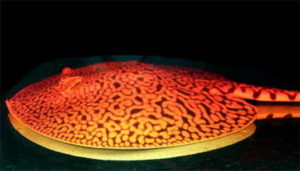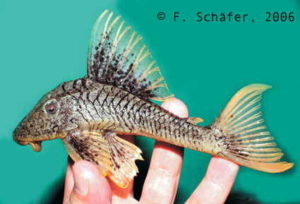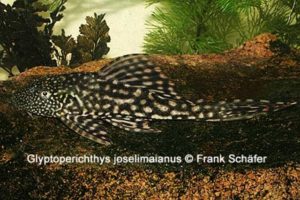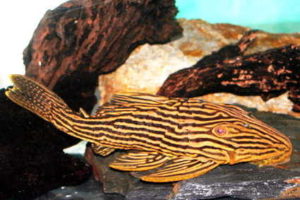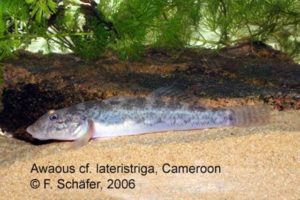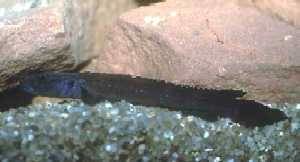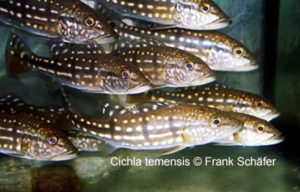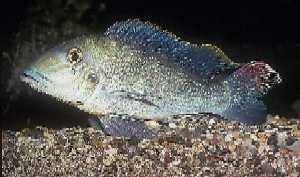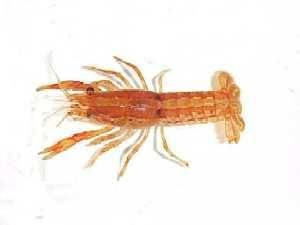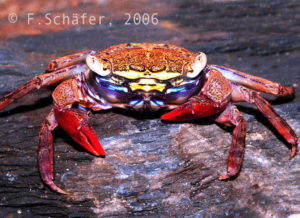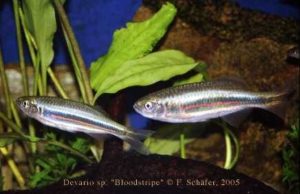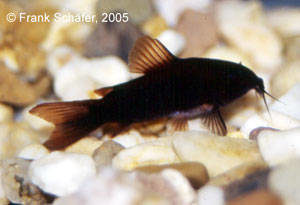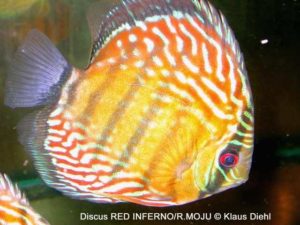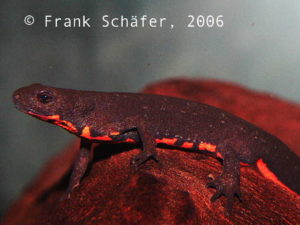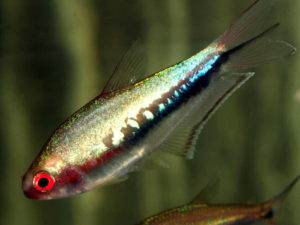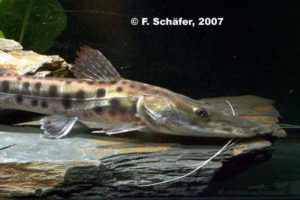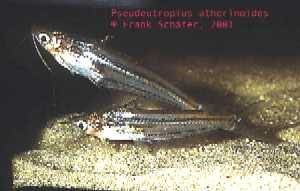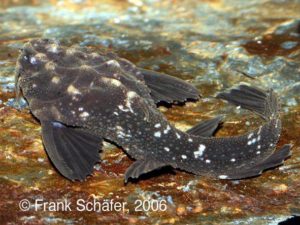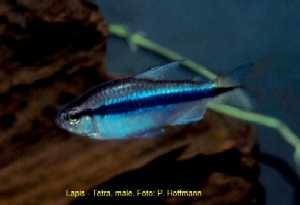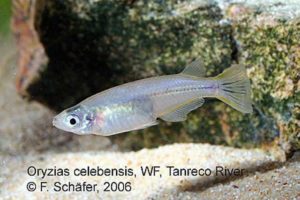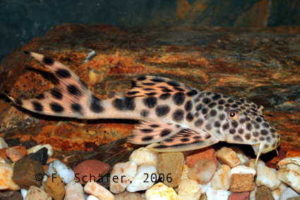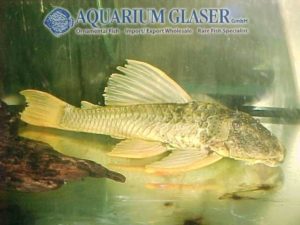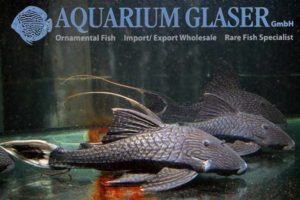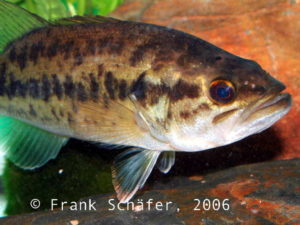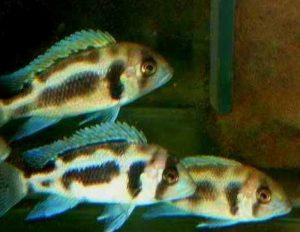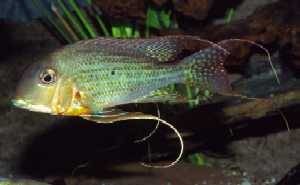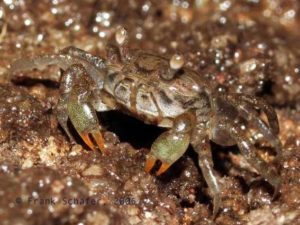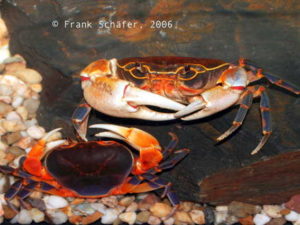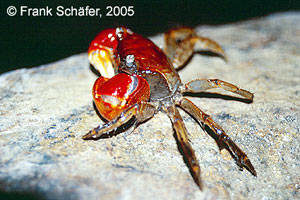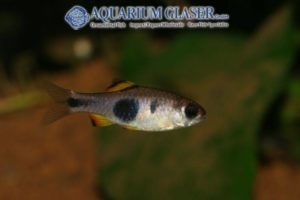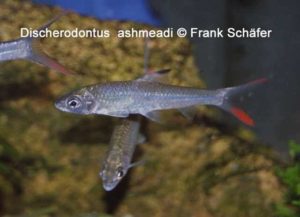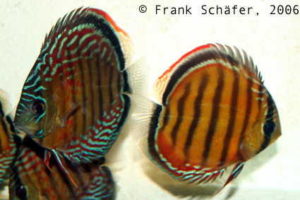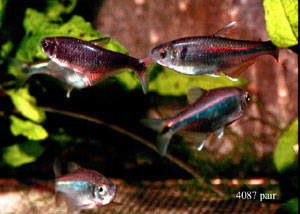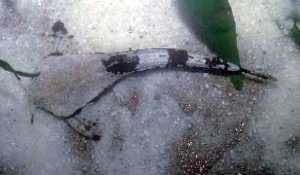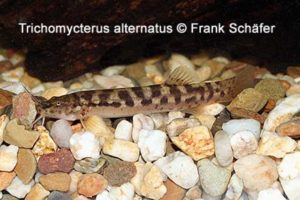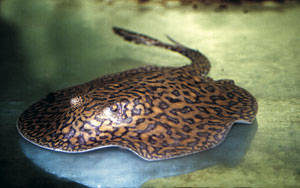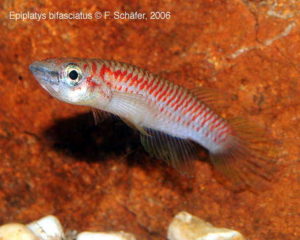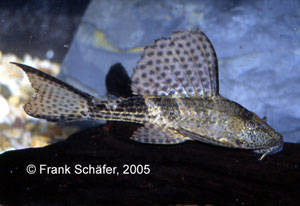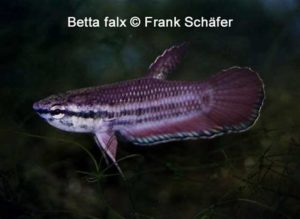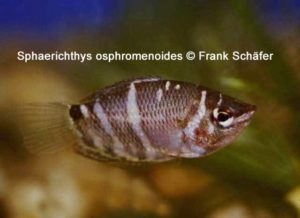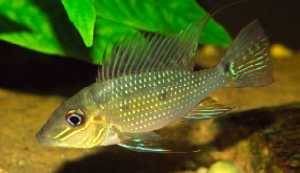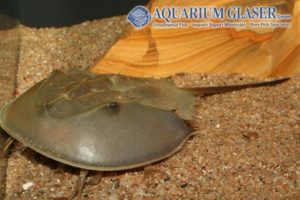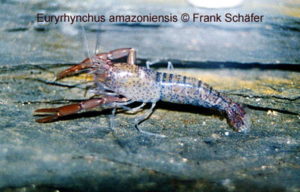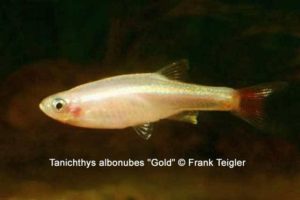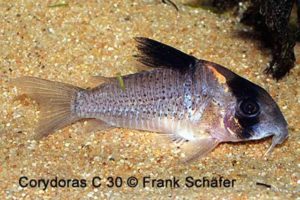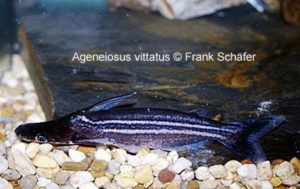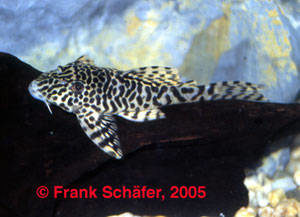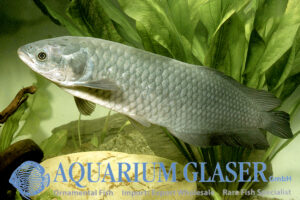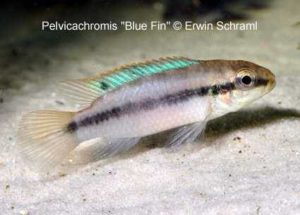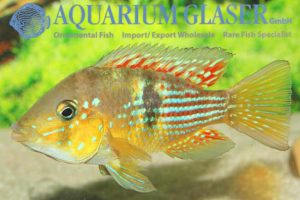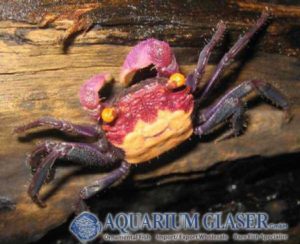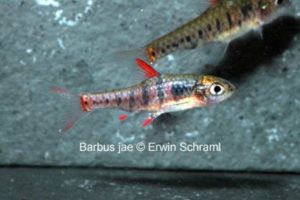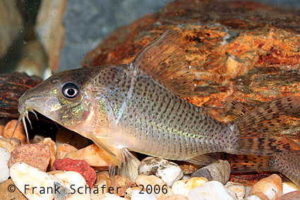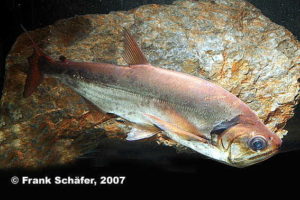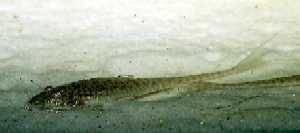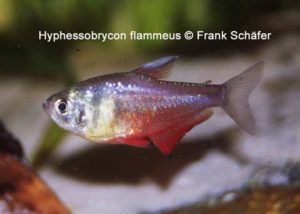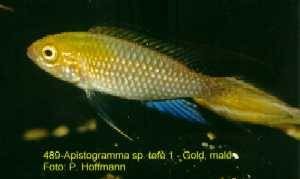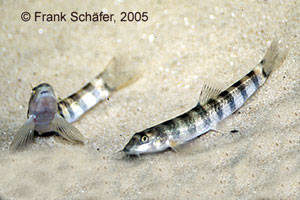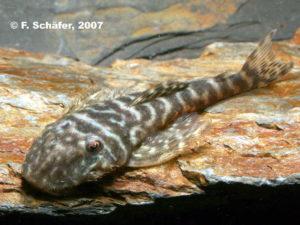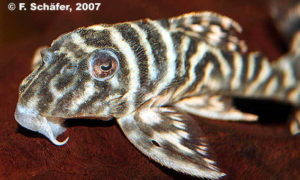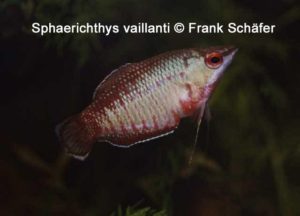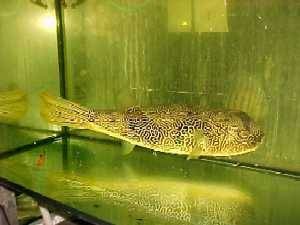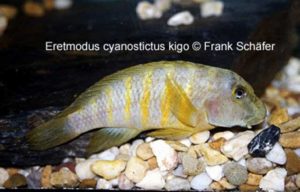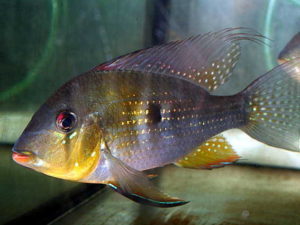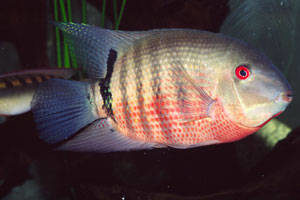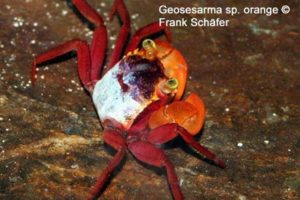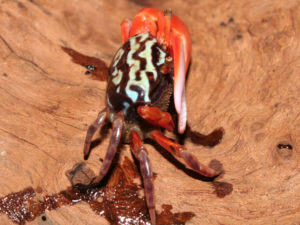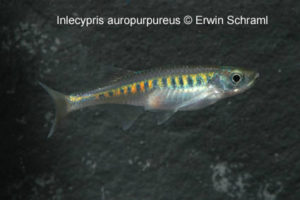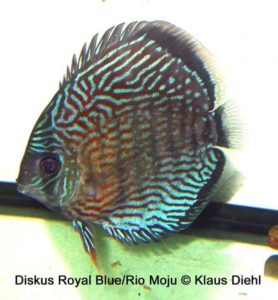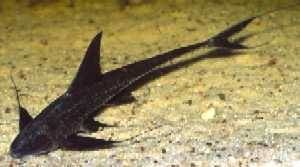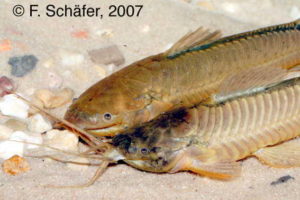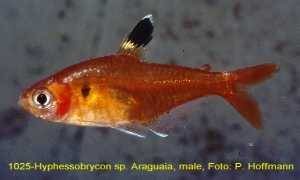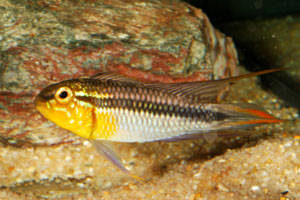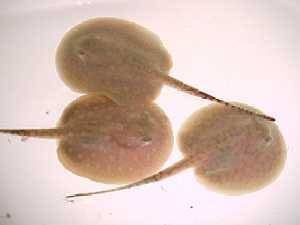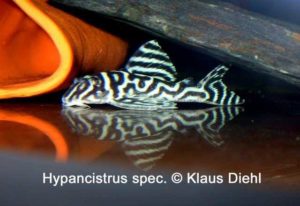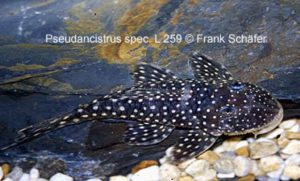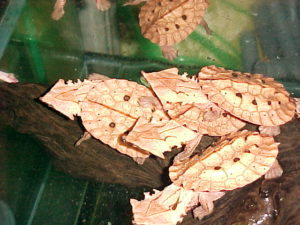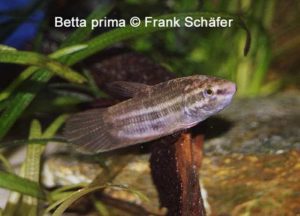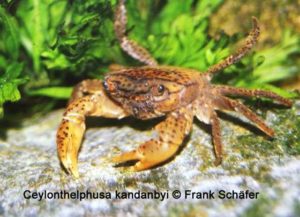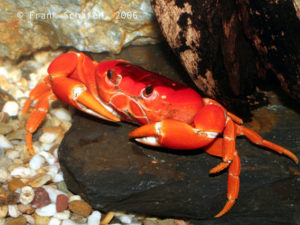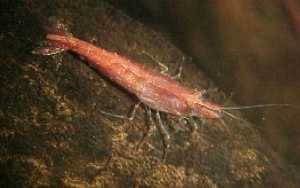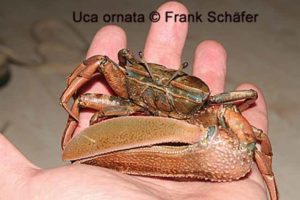The Clown Featherback is well known to the hobby and has been imported as early as 1934 from South-East Asia. They are nocturnal fish and when they get older they become solitary. The fish tank should be decorated with dense patches of plants on the sides and back but should be kept with enough swimming […]
Fish Archive (3100)
-
-
Ctenochromis polli
Ctenochromis polli occurring in the Congo River belongs to the rather rarely kept cichlids. Despite their body length of maximally 11cm they should not be kept in too small aquariums (100cm). The males are quite aggressive and pursue the females and suppressed males. They need sufficient hiding places, therefore the interior arrangement of the aquarium […]
-
Orthochromis stormsi
Orthochromis stormsi reached us as bycatch with Steatocranus casuarius. Both species originate from Central Africa, where they inhabit the cataracts of the Congo River. Their maximum size amounts to 12 cm, whereby the females remain somewhat smaller. The differences between sexes are only weakly pronounced, males appear more multicoloured, females have a darker basic colour. […]
-
Brotia pagodula
(28.Nov.2007) From Southeast Asia we got a still rarely traded snail species. Brotia pagodula is a live-bearing snail, as an endemic species it can be found only in the Moei, a river between Myanmar and Thailand. Their strongly wound house, provided with numerous spikes, gives them a bizzare appearance. On the search for algae they […]
-
Procambarus clarkii „WHITE“
Under the numerous color forms of the Red Swamp Crayfish is Procambaris clarkii „White ” at present very popular. They are tough tank inhabitants, easily to reproduct and possess a high reproduction rate. Procambarus clarkii does not place large requirements towards the water chemistry, a strong filtering is however necessary, since they have a strong […]
-
Devario regina
The Queen Danio (Devario regina) is a tropical fish belonging to the minnow family (Cyprinidae). Originating in India, Myanmar, Thailand, northwestern Malaya, and the Mekong basin it is quite rarely seen in our tanks. Other species often found in the same locality as D. regina are Puntius lateristriga, Rasbora paviei, various Poropuntius, Neolissochilus, Barilius, Nemacheilus […]
-
Astyanax leopoldi
Because of their rhomboid body form these animals remind one a little of African tetras of the species Phenacogrammus or Bathyaethiops. Except from Rio Oyapock Astyanax leopoldi are also said to be found in Rio Approuague. They were named in honour of King Leopold III of Belgium, who attended an ichthyological expedition to Rio Oyapock […]
-
Nannostomous espei
Up to now this ornamental tetra is only known from western Guyana/Southamerica in the lower course of Mazaruni River. Full-grown fish reach a total length of approx. 40mm. When putting on spawn the females are getting much plumper. By using their dish-shaped anal fin the males fix the eggs to a substrate (e.g. bottom of […]
-
Potamotrygon menchacai
September 2006: From Potamotrygon menchacai, the tiger stingray, we could import a big, very beautifully patterned, female animal with approximately 60 cm in diameter. Tiger-rays can be colored quite differently and particularly can differ in the contrast. Our tiger rays come from Peru, through size and scrutiny, they certainly are among the most impressive “ornamental-fishes.” […]
-
Cochliodon spec. var. marbled L 360a
From the drainage basin of the Tapajos arrived a new, until now not imported loricariid catfish at our facility. Body form and yellow fin seams remind strongly of L 360, the body and parts of the fins however exhibit a veining atypical for L 360. In their maintenance requirements they might probably not differ from […]
-
Glyptoperichthys joselimaianus L 1, L 22
Glyptoperichthys joselimaianus the “White Spot – Glycopterichthys” originates from the Rio Araguaia, one of the main tributaries of the Rio Tocantins in Brazil. There it inhabits different habitats, it was found e.g. on deadwood and also on flooded meadows. Natural water conditions (white water) do not have to be copied for maintenance, L 1 are […]
-
Panaque spec. „New Royal Golden Thunder“
September 2006: This week we succeeded in importing several of this beautiful new Panaque from Brazil. In their appearance they remind of L 27, are however flatter and slimmer than these. In addition they possess a larger mouth and their dorsal fin is smaller. These characteristics let assume that they originate from strongly flowing river […]
-
Awaous cf. lateristriga
From the coastal ranges of the western Africa between Senegal and Angola originates the freshwater goby Awaous lateristriga. The animal introduced here reminds strongly of this species, whether it is identical to it could yet not be determined. With an overall length of approx. 30 cm Awaous lateristriga belongs to the larger gobys. In their […]
-
Chitala ornata „Striped“
This variation of the Clown Featherback has a very marked body pattern. The breeding of C.ornata In captivity has been succeeded on several occasions. The fish spawn on the hard substrate and the eggs are guarded by the male fish, who also fawns the eggs. In nature the care of the spawn is important for […]
-
Teleogramma depressum
This rapid inhabitant from the lower Congo catchment area, which grows up to 10cm is generally regarded as the worlds flattest cichlid. At first sight it it looks like the little more known T. brichardi, but T. depressum – as the species name already tells – is distinctly more flattened, which you can especially see, […]
-
Cichla temensis
Cichla temensis does not represent a fish for everyone. We could import them from Venezuela, where they are estimated fishes for consumption and sold under the name Tucunare. In its natural environment they can reach an overall length of 1 m with a weight of approximately 10 kg. They grow to be the largest of […]
-
Retroculus lapidifer
To take sensibly care of Retroculus lapidifer, which comes from Rio Tocantins/Rio Araguaia catchment area, you should own quariums with a base of 150 x 60cm minimum, as this species can grow very big (25-30cm). But despite its size you should not socialize it with aggressive cichlids, because it has only a certain self-assertion among […]
-
Cambarellus patzcuarensis
November 2003: New arrival! The orange dwarf lobster, Cambarellus patzcuarensis. They grow only up to 3-4cm. Just yesterday we got a very limited quantity from a german breeder. These dwarf lobsters are slightly agressive among each other. The origin is the lake Patzcuaro in Mexico.(Photo F. Schäfer, Text K. Diehl)
-
Sesarma spec. „Neon Face“
April 2005: These days we got a new crab species from Asia. The blue green irisdescent coloration of its face advised the name „Neon Face“. If further information is available, we will add it to our text.(Photo F. Schäfer, Text K. Diehl)
-
Devario spec. „Bloodstripe“
This danio originating from Asia grows to approx. 12 cm . Devario spec. “Bloodstripe” represents an attractive enriching of the offered danio species. The habitat of the fish, drawn with a remarkable red strip, is located on the Indian subcontinent. Females are more corpulent and somewhat larger than males according to the typical danio pattern. […]
-
Corydoras ephippifer
This true mailed catfish species was imported from Belem (Brazil). The latin name „ephippifer“ is a combination from „ephippium“ (lat. = saddle) und „ferre“ (lat. = bearing) referring to the black spot on the basis of the dorsal fin. The animals reach a maximal length of 6 cm. They should be kept in a group. […]
-
Corydoras sp. BLACK VENEZUELA
A very beautiful colour morph bred in Germany and a true addition to our fascinating hobby. Corydoras aeneus (this fish probably belong to this family) is one of the most common true mailed catfish in the aquaristical hobby. Originally this cory species has a large distribution in nature which ranges from Trinidad, Venezuela, Surinam, Colombia, […]
-
Discus „Red Inferno/Rio Moju“
Only one example of at present in extraordinarily good quality arriving Diskus is the “Red Inferno” variant coming from the Rio Moju. On their fins and flanks the animals show a strongly red-orange basic colour, which stands in beautiful contrast to the bluish green wave pattern. The icing on the cake are their cherry-red eyes, […]
-
Cynops orientalis
In its eastern chinese habitat the Chinese Fire Belly Newt Cynops orientalis inhabits small standing to slowly flowing overgrown waters. Females can get up to 10 cm long, the males remains with approximately 8 cm somewhat smaller. They can be kept predominantly aquatic, but a small land part with hiding places and climbing possibilities is […]
-
Nematobrycon lacortei
The Rainbow Tetra is one of the most attractive characins of South America. They origin from western Colombia, where they are caught in the tributaries of the Rio San Juan. They belong to the same genus as the usually better known Emperor Tetra Nematobrycon palmeri. Rainbow Tetras can not be characterized as true schooling fishes, […]
-
Otothyris travassosi
This rarely imported catfish species originates from the federal states Bahia and Espirito Santo at the coast of brazil. With only 3cm of total length it belongs to the smallest Loricariids. There habitats are small and fast running streams. They mostly stay in areas thickly covered with vegetation. Otothyris travassosi is not a fish for […]
-
Pseudoplatystoma corruscans
The rarely traded largest shovelnose catfish Pseudoplatysoma corruscans originates from the Rio Sao Francisco in Brazil. This predator becomes quite large (approx. 180cm) and heavy (100 kg). They like to stay in groups and socialize well with rays, big charazins, cichlids or other catfishes. (Photo F. Schäfer, Text K. Diehl)
-
Pseudeutropius atherinoides
The „shark cats“ of the genus Pangasius are highly seeked for aquarium fishes, because their swimming behaviour reminds one on a shark. Sadly all species grow very fast and none of the species stays smaller than 50 cm, some even reach 150 cm or even more. For some time now so-called „mini-pangasius“ are introduced to […]
-
Amaralia hypsiura
January 2001: At present we can offer Amaralia hypsiura for friends of the extraordinary . This rarely dealt catfish attains full growth with approx. 15 cm length. It originates from the Amzon and there it feeds mainly, as gastric examinations of freshly caught fishes documents, predominantly the spawn of other fish. Fortunately they are not […]
-
Hyphessobrycon cyanotaenia, Lapis-Tetra
This tetra was introduced to us under the name of “Inpaichthys sp. Lapislazuli” in February 2002 by Mrs. Glaser-Dreyer (Aquarium Glaser GmbH). On the (Japanese) internet it is called Lapis tetra. It was imported in a bigger number of pieces without exact declaration of place of discovery. The males are growing up to at least […]
-
Oryzias celebensis
Oryzias celebensis the Celebes rice fish originates, as the species name indicates, from Indonesia where it inhabits the island Celebes. It lives in standing to slowly flowing waters which are heavily planted. As an approximately 5 cm large becoming schooling fish it needs a free swimming area and retreat possibilities, since rice fish occasionally tend […]
-
Ancistomus sabaji L124 „Big Spot“
Ancistomus sabaji – Hypostomus spec., Peckoltia spec.? A fish with many names! There is hardly another L number catfish where the confusion regarding the nomenclature is as large as with this species. This is a result of the generous allocation of numbers (L 75, L 124, L 301 and LDA 2) for this fish. One […]
-
Hypostomus luteus
From southern Brazil and northern Argentina originates the probably most beautiful representative of the genus Hypostomus. Contrary to many other loricariids they become more beautiful with increasing age, since the portion of the yellow body parts constantly increases. Their southern area of origin suggests a tolerance in relation to low temperatures. They can be can […]
-
Panaque spec. „Papa Ojo Chico“ L 90a
With L 90a we can offer at present one of the most beautiful Panaque species. Especially the extremely long, orange colored filaments of the caudal fin are remarkable. In addition, the discrete black markings on the noble-grey colored body let them appear very elegant. With the purchase of these fishes their final size (over 30cm) […]
-
Micropterus salmoides
Something special for your pond. The Largemouth Bass originates from the eastern part of the United States where they occur from the Canadian border down to Mexico. In the meantime they were spread in numerous countries as game fish and can therefore be found also in Europe. They prefer quiet, well warmed waters without a […]
-
Cyphotilapia frontosa var. „DARK BLUE HORIZON“
March 2005:New on our list and absolutely rare: Cyphotilapia frontosa var. “DARK BLUE HORIZON”. We are proud to present these only in extremely small number existing variant of the well-known Cyphotilapia frontosa. Beside the remarkable longitudinal striation the animals are characterised by a very intensive blue. Since so far only very, very few animals are […]
-
Geophagus altifrons
You can surely excellently argue about taste, but the various populations of Geophagus altifrons could justly conquer a solid place among Cichlid lovers. And one of the most beautiful variants might be Geophagus altifrons “Tapajos”. Additionally, G. altifrons is an easy-to-keep cichlid. It requires aquariums with at least 500 ltr. capacity due to its size […]
-
Camptandrium sp.
July 2006: Few days ago we could import a new attractive crab species. It belongs to the genus Camptandrium, the species is yet not determined. They originate from India, where they were caught on the banks of the Ganges river in the proximity Calcuttas. There they live in estuaries and a therefore a salt additive […]
-
Demanietta spec. Laos
From the border area of Laos and Thailand origins the expressed beautiful fresh water crab Demanietta spec. „Laos“. They exist in different colour forms. Fresh water crabs need an aquarium with a land- and water part. Some branches or stones will offer them climbing possibilities. As omnivores they despise nearly none of the usual crab-food, […]
-
Sesarmops intermedium, Flower Crab
This crab is known under the trading name “Flower Crab”. It will not outgrow 4 cm, measured by its carapace. These crustaceans have two large, red claws, which could weigh up to half the total body weight. In nature they feed mainly on algae and other organic material, which they catch with smaller pincers. The […]
-
Barbus hulstaerti
August 2006: Last night we received a small jewel from the Congo basin. For the first time a somewhat larger number, of the more than 30 years for the hobby lost Butterfly Barb Barbus hulstaerti could be imported. The lively fish, reaches 4cm in length and fascinates by its wonderful colors. In their area of […]
-
Discherodontus ashmeadi
The redtail barb Discherodontus ashmeadi originating from the tropical Southeast Asia can reach an overall length of up to 14cm. As habitat Mekong and Meklong are indicated. In their appearance the dark dorsal fin mark, as well as the strongly red markings of the caudal fin are particularly noticeable. In their habitat they inhabit brooks […]
-
Diskus Nhamunda rosé
Nhamunda Rosé is the trade name of a strain of the brown discus Symphysodon aequifasciatus axelrodi originated in the Rio Nhamunda (northern influent of Amazon, west the city Alenquer). Now again some Nhamunda Rosé are available. Characteristic for this variety is the partially laminar high red part of the brown primary colour. Thus they are […]
-
New China Tetra
-
Bunocephalus sp. „Black/White“
The banjocat new imported from Peru immediately attract attention due to their interesting colouring in contrast to other species of the same relation circle. Therefore some animals are almost unicoloured white while other specimens mainly show some irregular black markings. The care of this species does not differ from that of other relatives of this […]
-
Trichomycterus alternatus
One of the in the aquarium most easy to keep pencil catfishes is Trichomycterus alternatus. This species, originating from the Rio de Janeiro region, reaches an overall length of for 10cm and can be maintained in aquaria starting from 60cm length. These very shy fish, reminding in their appearance of our in Europe native Stone […]
-
Potamotrygon sp. „Mantilla ray“
This freshwater ray originates from Paraguay. The multitude of forms and colours never stops to amazes one. In the past the scientific description of freshwater rays used to be done according drawings without any conserved specimens from natural museum history collections. The classifications of live animals by such limited descriptions are almost impossible to make.(Photo: […]
-
Epiplatys bifasciatus
September 2000: At the moment, we can offer the Epiplatys bifasciatus. These approximately 5-6 cm long growing killifishes come from Guinea in West-Africa. There, they live in small savanna-brooks and swamps. No big aquariums are required for keeping of this fish, they should notbe socialized with active species since they can then become quite shy. […]
-
Hypostomus sp. „Chaco“
A close relative of the well known common plecos, is shown at the time of the importation not fully grown yet. This fish can easily grow up to 30 cm in length. This pleco is a harmless solitude fish, very well suited for the cichlid aquarium. It is an animal who has a nocturnal way […]
-
Betta falx
Betta falx, belonging to the Betta picta form circle, was scientifically described 1998 by Tan and Kottelat. Their origin is the central part of Sumatra, where it occurs in dense overgrown, nearly standing waters. The water conditions at the habitat (pH 5.7, GH 0 – 1, KH 0 – 1) do not have to be […]
-
Sphaerichthys osphromenoides
Sphaerichthys osphromenoides is the most famous representative of the in southeast Asia indigenous chocolate gouramis. Like other chocolate gouramis Sphaerichthys osphromenoides is a delicate and at least while settling down a sensitive fish. It’s natural biotope are shore areas of small, still and slow-moving black water on the Malayan peninsula. As a typical black water […]
-
Satanopera acuticeps
Normally the durable care of Satanopera acuticeps is only possible in soft and sour pH-value. But as it was finally successful to breed this eartheater inside the aquarium, it could be that the bred ones are easier to keep and even easier to breed. So far the breeding was possible furthermore only in soft (< […]
-
Carcinoscorpius rotundicauda
Horseshoe crabs are rightfully described as living fossils, because their ancesters populated the warm flat seas about 500 million years ago.The description of the horseshoe crab is misleading because their next relatives are arachnids and not the crabs. The Moluccan-horseshoe crab that is being presented, comes from southeast Asia and lives in coastal ranges from […]
-
Euryrhynchus amazoniensis
April 2006: Now available again: Euryrhynchus amazoniensis a rare shrimp species from South America. The delightful pattern of points and stripes on their body justifies its English name Peru Zebra Shrimp. For a long-lasting maintenance the only 3 cm large getting species needs low pH values and soft water, since otherwise a certain susceptibility against […]
-
Tanichthys albonubes „Gold“
Tanichthys albonubes “Gold” is a selection of the well-known White Cloud or White Cloud Mountain Minnow. They were imported since the end of the 30's of the past century and were called at that time “Working Man's Neon” or the “Poor Man's Neon”. This referred on the one hand to its attractive colouring, otherwise it […]
-
Corydoras sp. C 30
Corydoras C 30, a scientifically still not described species, originates from the area of the Amazon delta (Federal State Amapa) in Brazil. In its appearance it reminds of Corydoras melanistius a further north in Surinam and Guyana occurring species. Like all Corys C 30 should be held not in a to small group (5 – […]
-
Phenacogrammus cf. nigropterus
This new African tetra, presented by Dieter Bork in “Das Aquarium” 12/01 as “pastel-congo-tetra”, comes from Lake Maindombe (also known as “Lac Leopold II”) in the Democratic Republic Congo (Zaire). Ornamental fish breeder Winter was able to multiply them in a bigger number of pieces. The fins of the males are pulled out beautifully and […]
-
Ageneiosus vittatus
July 2002: For the first time we could import Ageneiosus vittatus from Peru. Slopehead catfish of the genus Ageneiosus are particularly noticeable by its strongly flattened head. These predators can reach an overall length of 30 cm. For the maintenance large basins are necessary. A dark bottom, some stones and bogwood should be brought in […]
-
Potamotrygon sp. „Maracaibo Ghost“
The ghost of Maracaibo. So a novel by Gabriel Garcia Marquez could be named, here however it is about a newly imported ray. Few specimen of these with Potamotrygon yepezi related species reached us last week from Venezuela. There they inhabit muddy bank sections in shallow, clouded waters in the supplies of lake Maracaibo. They […]
-
Peckoltia. spec. L 134
From the Rio Jamanxim (Brazil) comes one of the most attractive members of the genus Peckoltia. L 134 is very variably marked: as well as individuals with stripes there are also specimens with large round spots on the body. It is not known whether this difference in colouration denotes sex, but in at least one […]
-
Heterotis niloticus
As next the relative of the largest truly freshwater fish Arapaima gigas Heterotis niloticus has a large attractiveness. With a maximum length of scarcely about one meter it is however more suitable for the aquarium maintenance than its South American relatives. In Africa they originally inhabit different waters types south the Sahara. A difference to […]
-
Pelvicachromis spec. „Blue Fin“
November 2005: From Guinea the import of a still undescribed Pelvicachromis species surprised us. This species seems to mediate within the genus Pelvicachromis between P. roloffi and P. rubrolabiatus, since it carries characteristics of both species. Particularly the name giving bright blue-green dorsal fin of females is noticeable. Maintenance in pairs is appropriate, in larger […]
-
Gymnogeophagus meridionalis
If you search for a Cichlid for a society aquarium (120 l and up), G. meridionalis is almost unrestricted recommendable. Being a all eatingfish, it accepts every imaginable food, getting only approx. 10-12cm it is not growing too big and it also shows really beautiful colours. Besides it is not choosy regarding the water condition […]
-
Geosesarma sp. VAMPIRE
March 2006: They are among us. Fortunately only in a small number: Vampire crabs! With a close look the horror will pack you, remind the ends of its shears very strongly of the carnassial teeth of vampires. At night one would like to meet them with their shiny red eyes in no case. Now in […]
-
Barbus jae
The Jae barb is one rarely out of central Africa imported dwarf barb. With scarcely four centimeters of length they attained full growth and show an attractive red coloration on their fins. The red hue of the fins is more weakly pronounced with the females; their body exhibits predominantly beige-brown tones. In addition the females […]
-
Corydoras sp. C 71
August 2006: With Corydoras spec. C 71 we could import a further rare species from Brazil. They originate from the Rio Arua in the Federal State Para. With a final size of 6 cm they belong to the medium sized Corys. The requirements for their maintenance might be the same as for other Corydoras species. […]
-
Hydrolycus tatauaia
From Peru some sabre toothed Tiger Fishes of the species Hydrolycus tatauaia came to us. For the maintenance of these impressive hunters naturally roomy aquariums (> 1000l) are needed. Young specimen can be kept in swarms, in the wild even swarms of mixed species were observed. With ageing their aggression potential rises and they become […]
-
Pseudohemiodon thorectes
This catfish coming from Bolivia, belongs to the smallest of his relatives, measuring 13 cm maximum. It is mostly getting imported by travelling aquarium hobbyists. Regarding the water condition this kind is rather adaptable, as guide values of up to 400 µS/cm and a pH-value of 7.6 were measured. Approx. 25°C are quite enough for […]
-
Hyphessobrycon flammeus
The Flame Tetra, Fire Tetra, or Von Rio Tetra is a well established aquarium guest. Its origin is the proximity of Rio de Janeiro in Eastern Brazil, where it occurs in coastal rivers. As swarm fishes they need the society of conspecifics. Since the optical impression of the observer depends on the swarm size, it […]
-
Apistogramma sp. Tefé 1 – Gold
The first golden animals were found among a bred shoal of young, approx. 14 days old Apistogramma sp. Tefé 1. From them a breeding phylum for further generations of Golden Apistogramma developed. Their growth is plainly slower than the growth of the normal Apistogramma sp. Tefé 1 and their breeding is generally more difficult. Their […]
-
Potamotrygon sp. „Pearl“
From one of the most sought – after of the Amazonian stingrays in the hobby, Potamotrygon sp. “pearl” we could offer first European bred offsprings. Pearl rays got their names for the repeating pattern of pearl-like spots within black rings covering its dorsum. Their origin is the Rio Tapajos where it share its biotopes with […]
-
Schistura beavani (wrong determined: S. scaturigina)
This loach belonging to the family of River loaches (Baltoridae) originates from Darjeeling and Assam in the eastern Himalayan mountains, Northern India, Nepal and Bhutan, where it lives in fast streaming rivers. This is a peaceful species, which is suitable for a well-kept aquarium. This loach should be nurtured in a well filtered and aerated […]
-
Ancistrinae spec. L 189
Several adult specimen of L 189 the wormline – Orinko catfish arrived with an import of L 257 Pseudolithoxus tigris. On this shown male, the odontodes on the head, breast and ventral fin are clearly visible, that absolutely states a belonging in the Pseudolithoxus group. Puberty is approximately reached at 7 cm, it’s end size […]
-
Hypancistrus spec. Xingu
From lower parts of the Rio Xingu we received very high-contrasted Hypancistrus spec. Xingu. In their appearance they arrange between L 333 and fishes of the L 66 group. But they are clearly more flattened and stretched than L 333. From L 66 and their relatives (e.g. L 236) they can be distinguished by the […]
-
Sphaerichthys vaillanti
Sphaerichthys vaillanti is probably the rarest and most desired species of the Chocolate Gouramies. Their origin is Kalimantan the indonesian part of Borneo. Since they are black water inhabitants, the water equivalents should be adapted in the aquarium to it. This species does best in peat filtered water. Water must be changed often, and a […]
-
Tetraodon mbu
April 2002: Yesterday we received from the Republic of Congo, this beautiful Tetraodon mbu, the real congo-puffer. We got this item in this huge size never before.The maximum size cited in the literature is nearly 70cm. It is astounding how individuals differ in their behaviour: there are shy and also agressive ones. More details you […]
-
Eretmodus cyanostictus „Kigoma“
Eretmodus cyanostictus is among the group of cichlids called gobies. Gobies only occur naturally in the surge habitat of Lake Tanganjika, which is the upper meter of the water at the shoreline. They unique in that their swim bladder is non-functional, meaning that when they’re not swimming, they drop to the bottom like a rock. […]
-
Acarichthys heckelii
January 2007: At present we can offer particularly beautiful Acarichthys heckelii from the region around Santarem. These fish are characterised by an intensive yellow colouring of the body. It forms a beautiful contrast to the red eyes and their magnificent fin rays. Acarichthys heckelii has a large area of origin along the Amazon and the […]
-
Heros severus
Despite the fact that Heros severus is the type species of the Heros genus, this species is the most uncharacteristic representative of this group. This is mainly caused by its reproducing behaviour, which is mouthbreeding and untypical for Heros, because they are all substrate breeding. Also the coloration is different from the other members of […]
-
Geosesarma sp. „orange“
March 2006: The mandarin crab, a further still undefined Geosesarma species, reached us these days from Sulawesi. It is characterised by a very intensive red-orange colouring of the legs and particularly the claws as well as bright yellow eyes. Thus it represents a beautiful coloured contrast to the last week introduced vampire crab. Whether a […]
-
Uca annulipes
May 2005: One of the most beautiful fiddler crab, Uca annulipes has been available now. Fiddler crabs, a family of 65 species, live worldwide in tropical and subtropical areas where they inhabit beaches and swamps. They reach a length of no more then 2.5 to 3 cm. The male animals have one large and often […]
-
Danio aesculapii (=Danio sp. „Pantherinus“)
These minnows originate from Burma, does not grow over 4 cm and is therefore the smallest representative of the Danio genus. But now this beautiful barb fish has been imported by Aquarium Glaser and is now available for the dedicated aquarium hobbyist. As with all representatives of the Danio family, D. sp.„Pantherinus“ is a schooling […]
-
Inlecypris auropurpureus
Inlecypris auropurpureus belongs to in Inlé lake in Myanmar occurring endemic fish species. That about 6 cm long becoming swarm fish should be held in well planted to not too small (80cm) tanks. Since they are good jumpers, young animals of 1,5cm length can already jump over 10cm high, the tanks have to be completely […]
-
Diskus Royal Blue/Rio Moju
If an increase of beauty and charisma of the at 01.02.06 introduced Diskus variant Red Inferno/Rio Moju is still possible, then by the Royal Blues originating from the same river. When first seeing these fishes I remembered the headline of an old “aquarien magazin” article. In January 1972 Eduard Schmidt Focke a famous german discus […]
-
Cheirodon spec. „Gold Neon“
At present we can offer some Cardinals of the variety „Gold Neon“. This is one of some more in the wild rarely existing colour forms of Cheirodon axelrodi. Actually it is not clear whether this colour forms are distinct species or varieties of the cardinal. At the “Gold Neon” the blue colour strip is replaced […]
-
Pterosturiosoma microps
Pterosturiosoma microps is one of the regularly imported Loricariidae from Peru, although not in bigger quantities. Even though it is more impressing in colour by its soft black-grey, it can still arouse enthusiasm by its remarkable appearance and its impressive but graceful fins. But its steady nursing is not quite easy. Whereas the acclimatization probably […]
-
Microsynodontis polli
Microsynodontis polli is one of three poorly documented pygmy Synodontis species, the other two being M. lamberti and M. batesii. They origin from Western to Central Africa, M. polli is reported for the upper Niger in Guinea and Liberia. Their maintenance is no problem as long as the water is soft and slightly acidic, although […]
-
Callichthys spec. NEW
From southern Brazil we could import a probably new Callichthyid catfish species. The sexes can be easily differentiated on the basis the dark pattern at the head of the females. In their homeland they inhabit diverse waters types. As accessory air-breathers they can move over land if it gets necessary to reach other waters. Their […]
-
Hyphessobrycon haraldschultzi (= spec. „Araguaia“)
Red fish always attract interest amongst hobbyists, especially the intensively red coloured ones. Five years ago when we received the first animals of this tetra by the name of “Hyphessobrycon serpae – the real one” (wildcaught from Rio Araguaia), we were immediately enthusiastic, too. At first sight (still inside the transport bag) these tetras looked […]
-
Apistogramma agassizii ,,Abacaxis“
The fish in this picture shows the beautiful A. agassizii colour morph from the Rio Abacaxis, which lies in the middle part of the Amazon River in Brasil. Recently a number of new varieties are introduced to the hobby, originating from breeding as well as import of local colour morphs. We can only hope that […]
-
stingray-babies
July 2005: During the night from Sunday to Monday it was about time: We got three babies. About five weeks ago we had received a female from Pantanal River and we immediately noticed on arrival that this fish was not alone: It was pregnant. After five weeks now of intensive care, these three babies were […]
-
Hypancistrus spec. L 173
March 2005: Freshly arrived: Beautiful German breds of L 173. For the first time we can offer thereby more than a “handful” of these wonderful rare pieces. The large variability of their pattern is remarkable. The bluish glow is common in all the white of their fins. (Photo & Text K. Diehl)
-
Pseudancistrus spec. L 259
Pseudancistrus spec. L 259 originates from the surrounding of the city Pimental at the Rio Tapajos. As all Pseudancistrus species the males of L 259 show a characteristic “beard” of Odontodes (dermal teeth) during the spawning season. Contrary to the popular Hypancistrus species L 259 are vegetarians. Therefore Zucchini, cucumbers and further vegetables should be […]
-
Chelus fimbriatus
June 2006: Freshly arrived and very beautiful. From South America reached us few Mata matas. Their in jungle waters protruding camouflage lets it appear remarkable and bizarr in the aquarium.(Photo F. Schäfer, Text K. Diehl)
-
Betta prima
Betta prima originates from South East Thailand and Cambodia and is a member of the Betta pugnax group. They are found foraging along the dense vegetation of brooks, swamps and calm rivers. B. prima is a small species, they can reach the size of about 6 cm. They like well planted, and since they are […]
-
Haplochromis sp. Mburo Blacky
The “Mburo Blacky” is coming from Lake Mburo in Uganda. This species is undescribed until now and grows up to 12cm. It does not dig and do not eat plants, but it is rather agressive and therefor those fish need bigger tanks (1 meter in length and up) in which they can find places to […]
-
Ceylonthelphusa kandanbyi
The leopard crab Ceylonthelphusa kandanbyi represents an attractive addition to the offered crustaceans. This 1999 scientifically described species originates from Sri Lanka where it is found in the Bentota river system. According to statement of our supplier the animals were caught in the proximity of Mathugama city a town in the western part of Sri […]
-
Gercarcinus ruricola
This splendid land crab (Halloween-Crab, Gercarcinus ruricola) occurs in two colour variants, specifically with red or white base coloration. The colour variation involves both sexes. A mixed pair lived together in harmony for several weeks in my terrarium. These creatures are essentially vegetarian, but will occasionally take frozen foods intended for aquarium fishes, eg bloodworm. […]
-
Neocaridina sp FIRE/CHERRY
July 2004: Yesterday we got a limited number of this beautiful shrimp, which belongs to the family of Neocaridina. This type was imported one year ago, but also only in small numbers. They do not demand special water parameters and can be easily fed with common fish food. They can be kept in community tanks, […]
-
Uca ornata
January 2006: For the first time in Germany: The fiddler crab Uca ornata. We are proud to introduce this new species to the pet market. We got only few animals from Ecuador, hope however for further imports of this species. Further information for the maintenance of this at the Pacific coast from Ecuador to Nicaragua […]





